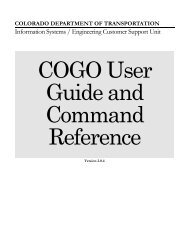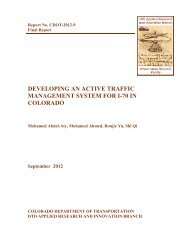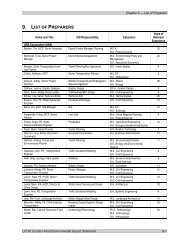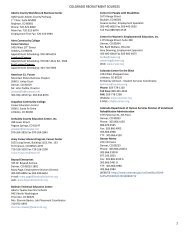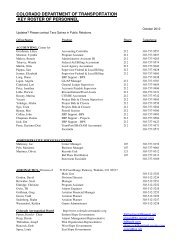Chapter 5 THE AUTOMOBILE AGE BEGINS, 1890-1930 - Colorado ...
Chapter 5 THE AUTOMOBILE AGE BEGINS, 1890-1930 - Colorado ...
Chapter 5 THE AUTOMOBILE AGE BEGINS, 1890-1930 - Colorado ...
Create successful ePaper yourself
Turn your PDF publications into a flip-book with our unique Google optimized e-Paper software.
A number of <strong>Colorado</strong> cities also showed ingenuity when constructing their first automobile<br />
roads. In 1909, a segment of one of the state’s oldest routes, the Santa Fe Trail, received a<br />
modern makeover after Pueblo County Commissioners contacted Thomas Tynan, warden of the<br />
<strong>Colorado</strong> penitentiary. The commissioners sought the use of 35 convicts to perform<br />
“experimental road work” towards hard surfacing a portion of the Old Santa Fe Trail located on<br />
Pueblo’s eastern city limits. Convicts graded an adobe roadbed for drainage, then placed a<br />
foundation of smelter slag from the <strong>Colorado</strong> Fuel & Iron plant, and rolled the material into the<br />
roadbed. Corrugated iron culverts placed below road level eliminated bumps along the surface.<br />
The final stroke required soaking and rolling a layer of gravel into the slag. After completion,<br />
residents of Pueblo boasted, “the Santa Fe Trail became the most modern section of highway in<br />
the West” (Taylor, March 1927: 9).<br />
The automobile brought rapid changes to <strong>Colorado</strong>’s cities, but many areas of the state had to yet<br />
to take part in this revolution. Residents of Southwestern <strong>Colorado</strong> sought a road east over the<br />
Continental Divide to open traffic between Alamosa, the San Luis Valley, and the rest of the<br />
state. The only route connecting the two regions at that time was a rough wagon road over<br />
Elwood Pass, where grades ran as high as 25 percent.<br />
Responding to those pleas in 1913, the Highway Commission searched for a way over the San<br />
Juan Mountains and considered both Elwood Pass and a recently surveyed route near Wolf<br />
Creek. The commissioners took a “hair-raising” ride over Elwood Pass’s 25-percent grade, and<br />
while the engine was still warm, immediately confirmed Wolf Creek the winner. During 1916,<br />
crews cleared Wolf Creek Pass at a cost of $100,000. Subsequently surfaced with dirt and<br />
gravel, the road measured from six-feet to 12-feet wide with occasional turnoffs allowing cars<br />
traveling in opposite directions to pass. To avoid expensive blasting over the South Fork<br />
Canyon, engineers located a portion of the roadbed along steep cliffs bordering the canyon. On<br />
completion of the road in 1916, drivers by the hundreds took a chance to cross the new pass<br />
(Federal Highway Administration, n.d.: 4).<br />
By the time of America’s entry into World War I, the state and federal government shared the<br />
same aspirations for better roads. <strong>Colorado</strong> was limited in the amount of roads it could build by<br />
Final<br />
CDOT Historic Highway Context<br />
5-21





